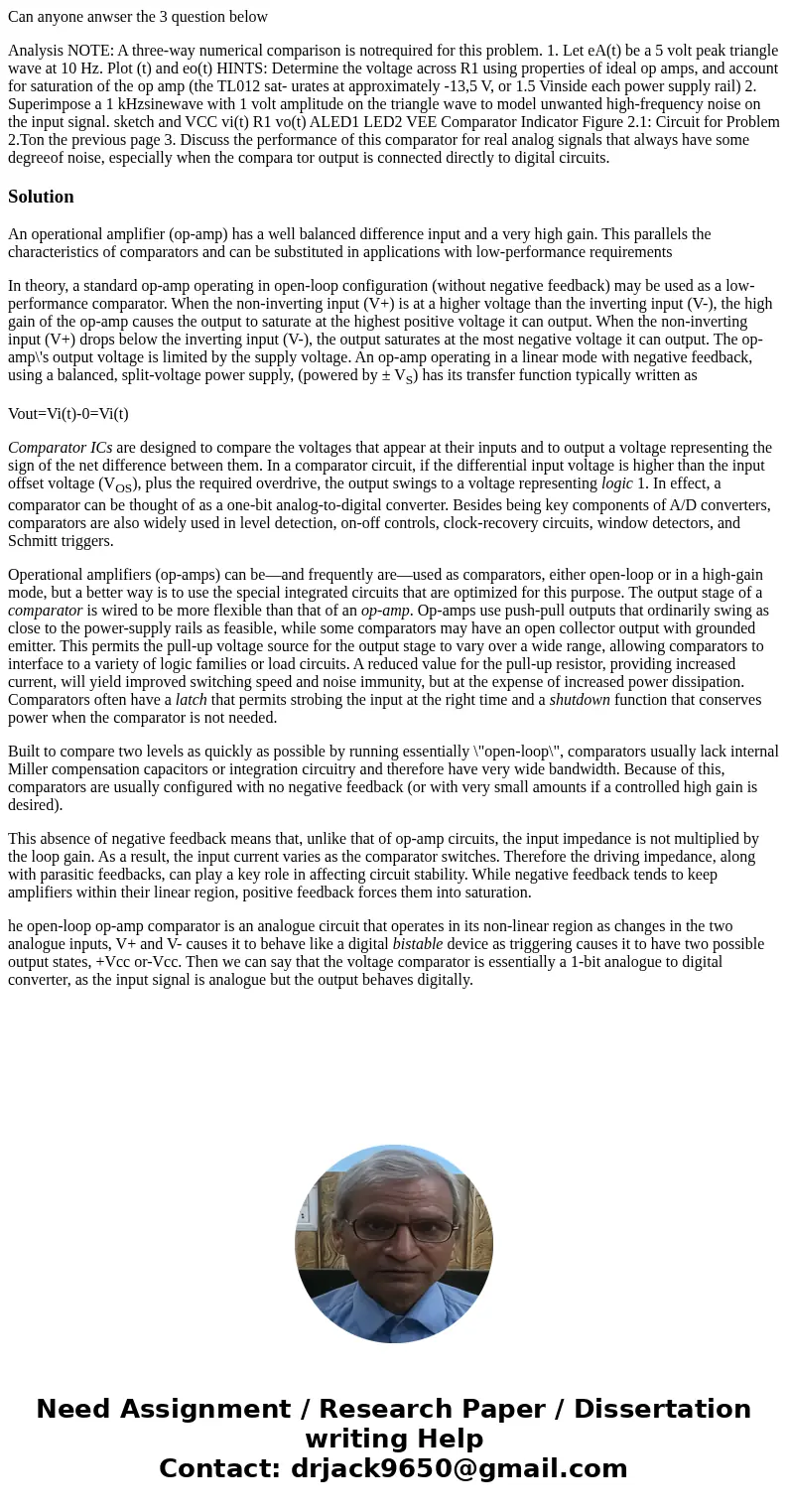Can anyone anwser the 3 question below Analysis NOTE A three
Can anyone anwser the 3 question below
Analysis NOTE: A three-way numerical comparison is notrequired for this problem. 1. Let eA(t) be a 5 volt peak triangle wave at 10 Hz. Plot (t) and eo(t) HINTS: Determine the voltage across R1 using properties of ideal op amps, and account for saturation of the op amp (the TL012 sat- urates at approximately -13,5 V, or 1.5 Vinside each power supply rail) 2. Superimpose a 1 kHzsinewave with 1 volt amplitude on the triangle wave to model unwanted high-frequency noise on the input signal. sketch and VCC vi(t) R1 vo(t) ALED1 LED2 VEE Comparator Indicator Figure 2.1: Circuit for Problem 2.Ton the previous page 3. Discuss the performance of this comparator for real analog signals that always have some degreeof noise, especially when the compara tor output is connected directly to digital circuits.Solution
An operational amplifier (op-amp) has a well balanced difference input and a very high gain. This parallels the characteristics of comparators and can be substituted in applications with low-performance requirements
In theory, a standard op-amp operating in open-loop configuration (without negative feedback) may be used as a low-performance comparator. When the non-inverting input (V+) is at a higher voltage than the inverting input (V-), the high gain of the op-amp causes the output to saturate at the highest positive voltage it can output. When the non-inverting input (V+) drops below the inverting input (V-), the output saturates at the most negative voltage it can output. The op-amp\'s output voltage is limited by the supply voltage. An op-amp operating in a linear mode with negative feedback, using a balanced, split-voltage power supply, (powered by ± VS) has its transfer function typically written as
Vout=Vi(t)-0=Vi(t)
Comparator ICs are designed to compare the voltages that appear at their inputs and to output a voltage representing the sign of the net difference between them. In a comparator circuit, if the differential input voltage is higher than the input offset voltage (VOS), plus the required overdrive, the output swings to a voltage representing logic 1. In effect, a comparator can be thought of as a one-bit analog-to-digital converter. Besides being key components of A/D converters, comparators are also widely used in level detection, on-off controls, clock-recovery circuits, window detectors, and Schmitt triggers.
Operational amplifiers (op-amps) can be—and frequently are—used as comparators, either open-loop or in a high-gain mode, but a better way is to use the special integrated circuits that are optimized for this purpose. The output stage of a comparator is wired to be more flexible than that of an op-amp. Op-amps use push-pull outputs that ordinarily swing as close to the power-supply rails as feasible, while some comparators may have an open collector output with grounded emitter. This permits the pull-up voltage source for the output stage to vary over a wide range, allowing comparators to interface to a variety of logic families or load circuits. A reduced value for the pull-up resistor, providing increased current, will yield improved switching speed and noise immunity, but at the expense of increased power dissipation. Comparators often have a latch that permits strobing the input at the right time and a shutdown function that conserves power when the comparator is not needed.
Built to compare two levels as quickly as possible by running essentially \"open-loop\", comparators usually lack internal Miller compensation capacitors or integration circuitry and therefore have very wide bandwidth. Because of this, comparators are usually configured with no negative feedback (or with very small amounts if a controlled high gain is desired).
This absence of negative feedback means that, unlike that of op-amp circuits, the input impedance is not multiplied by the loop gain. As a result, the input current varies as the comparator switches. Therefore the driving impedance, along with parasitic feedbacks, can play a key role in affecting circuit stability. While negative feedback tends to keep amplifiers within their linear region, positive feedback forces them into saturation.
he open-loop op-amp comparator is an analogue circuit that operates in its non-linear region as changes in the two analogue inputs, V+ and V- causes it to behave like a digital bistable device as triggering causes it to have two possible output states, +Vcc or-Vcc. Then we can say that the voltage comparator is essentially a 1-bit analogue to digital converter, as the input signal is analogue but the output behaves digitally.

 Homework Sourse
Homework Sourse